Eel, Sidat, Sea Eel (Synbranchoidae and Murainidae)

Moray eel (Photo Credit : Carribean Reef Life)
Eel, Sidat, and Sea Eel, all three are fish that at first glance look similar in body shape. Generally, we know eels and sea eels. Eels refer to fish that live in freshwater, while sea eels are fish that have a similar shape but live in the sea. So what about sidat? Here is a summary of some characteristics that distinguish these families of animals.
|
Taxonomy |
Eel |
Sidat |
Sea Eel |
|
Class |
Teleostei |
Actinopterygii |
Actinopterygii |
|
Ordo |
Synbranchiformes |
Anguiliformes |
Anguiliformes |
|
Sub Ordo |
- |
Anguilloidei Nemichthyoidei Congroidei Synaphobranchoidei |
Anguilidae |
|
Family |
Synbranchoidae |
Murainidae |
Murainidae Congridae Ophichthidae |
|
Genus and Species |
Genus Macrotrema ● M. caligan (estuarine eel) Genus Monopterus ● M. albus (rice field eel) Genus Ophisternon ● O. aenigmaticum ● O. afrum (belut Guinea) ● O. bengalense ● O. candidum (cave eel) Genus Synbranchus ● S. lampreia ● S. madeirae |
Genus Anguiela ● Anguilla bicolor ● Anguilla bicolor pacifica ● Anguilla borneensis ● Anguilla marmorata ● Anguilla celebensensis ● Anguilla megastoma ● Anguilla interioris |
Murainidae: ● Gymnothorax undulatus (kerondong) ● Gymnothorax dorsalis ● Gymnothorax isingteena ● Gymnothorax javanicus ● Gymnothorax pictus ● Gymnothorax pseudothyrsoideus ● Muraena retifera (armang eel) Congridae: ● Conger sp (white eel) ● Conger myriaster ● Conger erebennus ● Conger cinereus (long fin conger) Ophichthidae: ● Strophidon Sathete |
- Sidat Fish (Anguilla spp.)
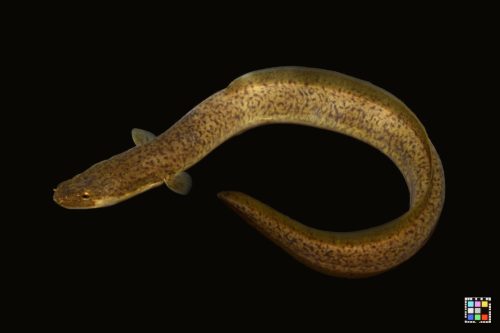
Anguilla marmorata (Photo Credit : Ffish.asia)
Distributed in the Indo-Pacific, Atlantic, and Oceania. Of the total 18 species of sidat, Indonesia has 7 types, 5 of which are endemic to Sulawesi. Sidat is grouped into 2 major categories based on their dorsal position: long fin and short fin. The short fin group includes Anguilla bicolor, while the long fin group includes Anguilla borneoensis, Anguilla marmorata, Anguilla celebesensis, Anguilla megastoma, and Anguilla interioris (KKP 2011).
Habitat of Sidat Fish
Able to adapt to freshwater, estuarine, and marine habitats. They prefer clear, flowing waters. Sidat is a catadromous fish, meaning it spends its adult life in upstream rivers or lakes but migrates to the sea to spawn when its gonads mature. Spawning is estimated to occur at a depth of 400-500 meters with a temperature of 16-17°C and a salinity of 35 ppt. The number of eggs produced (fecundity) by each female ranges from 7 million to 13 million with a diameter of about 1 mm (Matsui, 1982). The eggs rise to the surface and hatch into larvae within 4-5 days. After spawning, the parent sidat usually dies.
The larvae carried by currents will metamorphose into leptocephalus (leaf-shaped) and continue to travel across the ocean towards the coast/freshwater.
After reaching the coast within one to three years, they transform into glass eels with transparent bodies, showing their bright red gills and liver. In Pelabuhan Ratu, glass eels reach river estuaries at a size of 45-60 mm (0.15–0.2 g), while in Europe they reach 75-90 mm. Upon reaching the coast, glass eels enter river estuaries and continue upstream, living in the upper reaches of rivers, lakes, and swamps, or residing in tidal swamp waters or brackish waters.
Morphology
- The body of sidat is relatively small and elongated.
- It has fine scales with a unique pattern.
- It has fins. One of the distinctive features of sidat is the presence of pectoral fins located behind the head, resembling ear lobes.
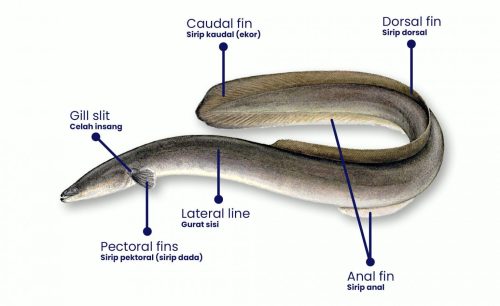
Sidat Morphology (Photo Credit : Sidat Labas)
Reproduction of Sidat Fish
Sidat has 5 life stages: larva, glass eel, yellow eel, silver eel, and adult eel. The first stage is asexual, while the last is sexual. The gonad development of sidat is very unique, and its sex develops according to environmental conditions. At the juvenile stage, its sexual condition is ambivalent, so there is no clear distinction between male and female. In the next stage, some gonads develop into ovaries and some into testes, with half of the population being male and the other half female.

Sidat life cycle (Photo Credit : Sidat Labas)
Its life cycle is complex, after growing and developing for a long time in freshwater, the adult sidat, known as yellow eel, develops into a silver eel (gonad mature) that migrates to the sea to spawn (Rovara et al., 2007).
Benefits
Contains high levels of Omega 3 Fatty Acids, Vitamin A, and Vitamin B12, which are good for human health. Cultivated to meet market demand (restaurants) in areas like Kulon Progo, Sukabumi, and Cilacap, although in this cultivation, the seeds (glass eel) are still captured from the sea. The species popular and with great potential for development are Anguilla bicolor and Anguilla marmorata.
- Sea Eel
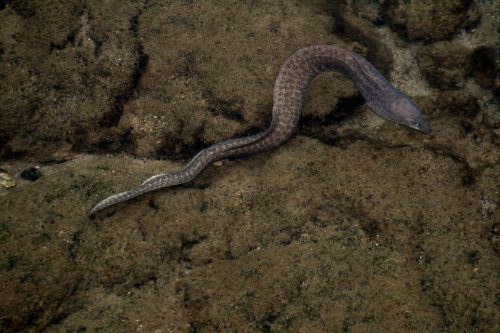
Gymnothorax undulatus (Photo Credit : Brocken Inaglory)
There are more than 300 species of sea eel, grouped into over 50 genera. Sea eels are in the same family as sidat. They are slender fish that live in corners and crevices of coral reefs. The lack of pectoral fins makes sea eels poor swimmers; instead, they lie in wait almost motionless in crevices, waiting for food to swim close. Three families of sea eels are:
- Muraenidae
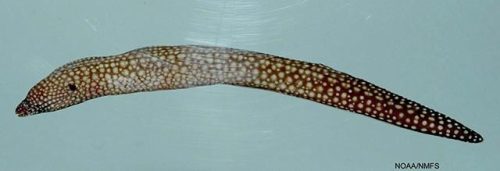
Muraena retifera (Photo Credit : NOAA/NMFS/Mississippi Laboratory)
- Habitat: shallow marine waters.
- Have poor vision but a highly developed sense of smell.
- Continuously open their mouths, revealing their sharp teeth, which can appear threatening but is actually how they breathe.
- Have two sets of jaws – the visible outer jaws and the pharyngeal jaws hidden in their throats, which help in grasping and tearing their food.
- Do not have scales; their bodies are covered in a layer of mucus, which can be toxic in some species.
- Carnivorous, feeding on fish, crabs, cephalopods, and mollusks.
- Capture prey by ambushing and then wrapping their bodies around it.
- Prey to other predators.
- Can release up to 10,000 eggs.
- Congridae
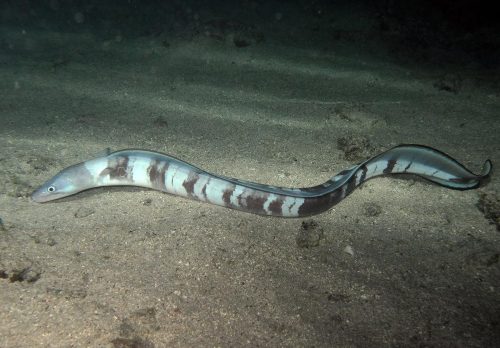
Conger cinereus (Photo Credit : Philippe Bourjon)
- The largest fish in the eel group, reaching lengths of up to 3 meters and weighing more than 100 kg.
- Females are longer and heavier than males.
- Live in deeper waters compared to other sea eel families. They spend days on the seabed, usually in holes and crevices in rocks, and come out to hunt at night.
- Inhabit sandy and rocky areas, hiding in holes and crevices during the day and emerging to hunt at night.
- Lay eggs at very deep depths, more than 2000 meters.
- Reach sexual maturity at 5 to 15 years and die after spawning.
- Have pectoral fins.
- Ophichthidae

Strophidon sathete (Photo Credit : moray_eel)
This type includes species known as "worm eels" or "snake eels," which have long, slender bodies adapted for living in burrows or crevices and are skilled at slipping through small holes and hiding in narrow spaces. Despite looking like snakes, they are not reptiles but fish.
Sea Eel Habitat
Inhabit the sea floor and behind rocky corals, mostly showing only their heads while displaying their wide mouths with sharp teeth, making them appear intimidating. With their sharp teeth, morays can cause serious injury to divers who disturb or try to play with them. However, such attacks are very rare, as they are essentially non-aggressive and shy animals. They are active at night, searching for food such as starfish, octopuses, squids, and sometimes even scavenging dead animals.
Sea Eel Morphology
Their bodies are elongated, resembling snakes. They are also called sea eels because their bodies are similar to eels with very small scales, having elongated ventral and dorsal fins. Generally, their bodies are spotted and brightly colored, with lengths reaching 1 to 4 meters and weights over 36 kg. The longest moray ever found was the giant slender moray (Strophidon sathete), reaching up to 4 meters. Morays live solitarily, spread across tropical waters worldwide, including Indonesia.
Sea eels have a round, elongated body shape. Relatively small pectoral fins are located right behind the head and merge with the tail and anal fins. The elongated body shape resembles a snake. The body length of sea eels varies depending on the species, ranging from 50-125 cm. Their three fins, including the dorsal fin, anal fin, and tail fin, are fused.
Their rear teeth are curved and primitive, but the strong biting mechanism makes bites on humans more severe, as the eel cannot release its grip even after death. While the majority are not believed to be venomous, evidence suggests some species might possess venom.
Reproduction of Sea Eel
Moray eels tend to mate when the water warms up towards the end of summer. Moray eel fertilization is oviparous, meaning that eggs and sperm are fertilized outside the womb, in the surrounding water, known as spawning. More than 10,000 eggs can be released at a time, which develop into larvae and become part of the plankton. It can take up to a year for moray eel larvae to grow large enough to swim to the seabed and join the community below.
Role and Benefits
Some types become commercial fishery commodities, and others are useful for their role as indicators of Ciguatera poisoning. Their presence in habitats associated with coral reefs around coralgroupers (Plectropomus pessuliferus) adds to the biodiversity and is an attraction for marine ecotourism. Their role in the food chain is as carnivores, primarily feeding on other fish, squid, mollusks, and crustaceans, but they also fall prey to natural predators like groupers, barracudas, and sea snakes.
- Muraenidae
- Eel

Ophisternon aenigmaticum (Photo Credit : Delmer Jonathan)
Eels belong to the Family Synbranchidae. Currently, the Family Synbranchidae consists of four genera and is known to have 20 species. It is estimated that many species have yet to be recorded and identified. Found in all geographic areas, they are carnivorous and cannibalistic animals. All species in this family are predators, usually preying on small animals in swamps or rivers, including fish, frogs, insects, and small crustaceans.
Eel Habitat
- Classified based on their habitat, eels are widely distributed in freshwater, in shallow muddy waters, riverbanks, canals, lakes, and ponds with depths of less than 1 meter. They have a respiratory aid in the form of a thin mucous membrane located in the mouth cavity, allowing them to live in habitats with 80 percent mud.
- They are tolerant and can adapt to cold-temperature areas. As long as their habitat contains water, eels do not require specific climatic or geographical conditions.
- In their habitat, eels can create hiding holes in the mud and survive in freshwater, from lowlands to highlands up to 1,200 meters above sea level.
- They can live in oxygen-poor waters and on the seabed with high organic content. However, in the larval phase, their seeds cannot survive in low-oxygen waters.
- Eels are now found in swamps worldwide, such as in Hawaii and Florida, and Georgia in the United States, where they are considered invasive animals.
Eel Morphology
This fish can be said to lack fins, except for a reduced tail fin. Another characteristic of eels is that they are scaleless (or have very few scales), have slimy skin, can breathe air, have narrow gill openings, lack a swim bladder, and have no ribs. Eels are land-water animals, and their eyes are mostly non-functional, with some species living in caves being blind. Body sizes vary. Monopterus indicus measures only 8.5 cm, while the marbled eel (Synbranchus marmoratus) can reach up to 1.5 meters. The rice field eel (Monopterus albus) can reach about 1 meter in length.
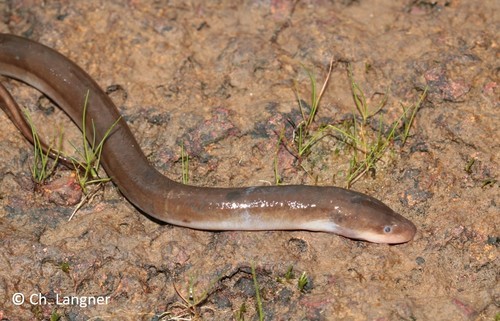
Monopterus indicus (Photo Credit : Christian Langner)
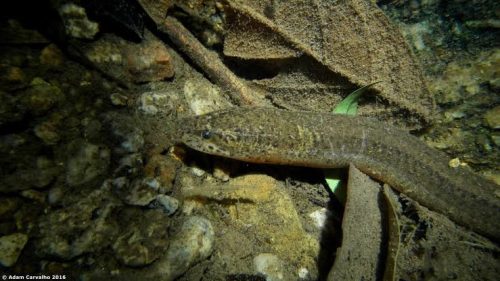
Synbranchus marmoratus (Photo Credit : Adam Carvalho)
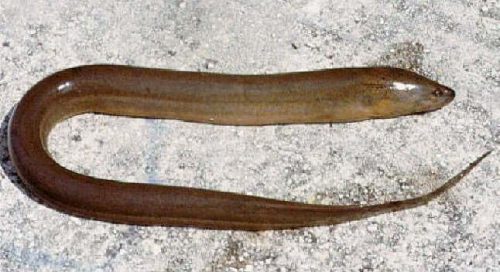
Monopterus albus (Photo Credit : Leo G. Nico/USGS)
Most eels do not like to swim and prefer to hide in the mud. All eels are predators, usually preying on small animals in swamps or rivers, such as fish, frogs, insects, and small crustaceans.
Eel Reproduction
Eels are hermaphrodites. In their youth, they are female and nest in holes to lay their eggs in shallow water foam. When the eggs hatch, young eels emerge, all female. In later development, they become male eels. Eels reproduce through oviparity. Eel mating occurs at night with temperatures below 28°C. After the female eel arrives, mating occurs, and the fertilized eggs are sucked by the male eel and stored in hiding holes. The eggs hatch about 9 to 10 days later. To differentiate the sex of eels, observe their body size: female eels are generally about 10-30 cm long, while male eels exceed 40 cm. Male eels approach shallow waters to create mating holes. After the female eel arrives, mating occurs, and the eggs are fertilized.
-YN

